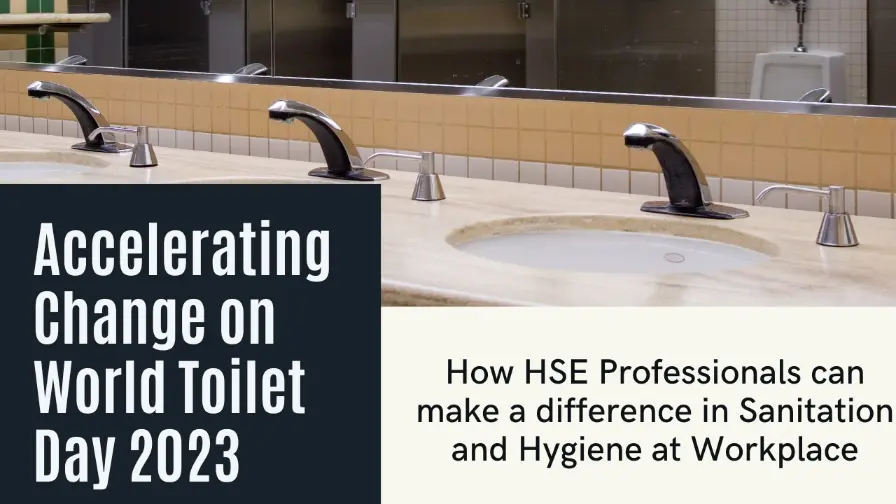Access to toilets is more than a convenience; it’s a basic human right. The correlation between sanitation and overall well-being is undeniable. Imagine a world where this fundamental need is not met and the consequences are dire, affecting both physical and mental health.
1. The Basic Human Need: Access to Toilets
In the hustle and bustle of our daily lives, there’s a fundamental aspect often overlooked – access to toilets. This basic human need is more critical than we realize, influencing not just personal well-being but also productivity in various settings, including the workplace.
As we approach World Toilet Day 2023, it’s time to shed light on the implications of lacking access to toilets
2. Worldwide Statistics:
2.3 Billion People Lack Basic Sanitation:
According to the World Health Organization (WHO), approximately 2.3 billion people worldwide do not have access to basic sanitation facilities, including toilets.
4.2 Billion Lack Safely Managed Sanitation Services:
UNICEF and WHO report that 4.2 billion people globally lack access to safely managed sanitation services, which ensure the safe disposal of human waste.
1 in 4 Health Facilities Lack Basic Sanitation:
Shockingly, one in four health care facilities globally lacks basic sanitation services, posing significant health risks for patients and healthcare workers.
Open Defecation Still Prevalent:
The practice of open defecation remains a challenge, with over 600 million people resorting to this unsafe practice, contributing to the spread of diseases.
Impact on Children’s Health:
Poor sanitation is a leading cause of waterborne diseases, affecting millions of children. Diarrhea, linked to inadequate sanitation, is a major contributor to child mortality.
3. Workplace Statistics:
25% of the Global Workforce Lack Workplace Toilets:
The International Labour Organization (ILO) estimates that approximately 25% of the global workforce does not have access to adequate workplace toilets.
Construction Industry Challenges:
In industries like construction, where mobility is common, the lack of proper toilet facilities is a significant challenge, affecting the health and well-being of workers.
Loss of Productivity Due to Inadequate Toilets:
The World Bank highlights that inadequate sanitation facilities in the workplace contribute to a loss of productivity due to employee absences and health issues.
Impact on Women in the Workplace:
Women face specific challenges, with a lack of private and sanitary facilities in workplaces affecting their overall well-being and comfort.
These statistics underscore the urgent need for global initiatives to address the issue of inadequate access to toilets, both on a societal level and within the workplace.
The lack of proper sanitation facilities not only jeopardizes individual health but also hinders economic productivity and social well-being.
4. Implications of Lacking Access to Toilets
The absence of proper toilet facilities goes beyond mere inconvenience. It poses serious health risks and has a tangible impact on productivity in workplaces globally.
Here are key implications of having no access to toilets at the workplace:
4.1 Health Risks:
Without adequate toilets, employees may resort to unsanitary practices, increasing the risk of the spread of diseases. Poor hygiene can lead to various health issues, affecting both individual employees and the collective workforce.
4.2 Decreased Productivity:
The lack of access to toilets can result in frequent breaks and disruptions as employees may need to leave the workplace premises to find suitable facilities. This can lead to a decrease in overall productivity and efficiency.
4.3 Discomfort and Stress:
Inadequate toilet facilities create discomfort and stress for employees. The inability to access clean and private toilets can negatively impact the mental well-being of workers, contributing to workplace stress and dissatisfaction.
4.4 Impact on Morale:
Employee morale is closely tied to the working conditions provided by the employer. The absence of proper toilet facilities sends a message of neglect and can lead to a decline in overall morale and job satisfaction.
4.5 Hygiene and Work Environment:
Poor hygiene resulting from a lack of toilets can compromise the overall cleanliness of the workplace. This not only affects the immediate working environment but also contributes to an unhealthy atmosphere for everyone.
4.6 Gender Disparities:
In workplaces with inadequate toilet facilities, women may face particular challenges. The lack of private and clean toilets for women can contribute to gender disparities and may even discourage female participation in certain industries.
4.7 Increased Sick Leave:
In the absence of proper sanitation, the likelihood of employees falling ill due to preventable diseases rises. This can result in increased sick leave, leading to additional costs for the organization and disruptions in workflow.
4.8 Violations of Dignity:
Every individual has the right to work in an environment that respects their dignity. The lack of proper toilet facilities can lead to situations where this basic right is compromised, contributing to a negative workplace culture.
4.9 Retention and Recruitment Challenges:
Organizations with inadequate facilities may face challenges in retaining existing talent and attracting new employees. A lack of proper amenities can be a deterrent for potential hires, impacting the organization’s ability to build a strong workforce.
4.10 Legal and Compliance Issues:
In many regions, regulations and labor laws mandate the provision of proper workplace facilities, including toilets. The absence of these facilities may lead to legal repercussions and compliance issues for the organization.
Addressing these implications requires a proactive approach from employers, emphasizing the importance of proper sanitation facilities to ensure the well-being and satisfaction of the workforce.
5. Challenges and Benefits in Ensuring Access
Addressing the challenges of ensuring access to toilets is crucial. From budget constraints to logistical issues, the hurdles are real. However, the benefits far outweigh the challenges. Improved access to toilets results in healthier, happier employees and contributes to a more productive workplace.
6. World Toilet Day 2023: A Call to Action
World Toilet Day, celebrated annually on November 19th, serves as a powerful platform to address this concern. It goes beyond raising awareness; it’s a call to action for individuals, businesses, and governments to prioritize and invest in proper sanitation facilities.
7. Taking Action on World Toilet Day
World Toilet Day is not just a date on the calendar; it’s an opportunity for meaningful action. Encourage readers to participate actively in events, share their experiences, and contribute to the ongoing dialogue about toilet access. Every voice matters.
In summary, access to toilets is not merely a logistical consideration but a fundamental human right. World Toilet Day serves as a poignant reminder of the work yet to be done. As we navigate the challenges and opportunities ahead, let’s remember that change begins with awareness and action.
8. Frequently Asked Questions
Q1: Why is access to toilets considered a basic human need?
Ans1:Access to toilets is fundamental to maintaining personal hygiene and overall well-being. It is recognized as a basic human right to ensure dignity and health.
Q2:How can HSE professionals contribute to improving toilet access?
Ans2: HSE professionals can drive change by advocating for better facilities, implementing awareness campaigns, and collaborating with decision-makers to prioritize sanitation.
Q3: What are the health implications of lacking access to toilets?
Ans3: The lack of proper sanitation facilities can lead to various health issues, including the spread of diseases and infections, affecting both individuals and communities.
Q4: How can individuals participate in World Toilet Day?
Ans4: Individuals can participate by engaging in events, sharing information on social media, and supporting initiatives that aim to raise awareness about the importance of toilet access.
Q5: What are the long-term benefits of improving toilet access in the workplace?
Ans5: Improved toilet access contributes to a healthier and more productive workplace, fostering employee well-being, morale, and overall organizational efficiency.
For future updates, suggestion and discussion, please connect with us on Facebook, Twitter & Linkedin.






